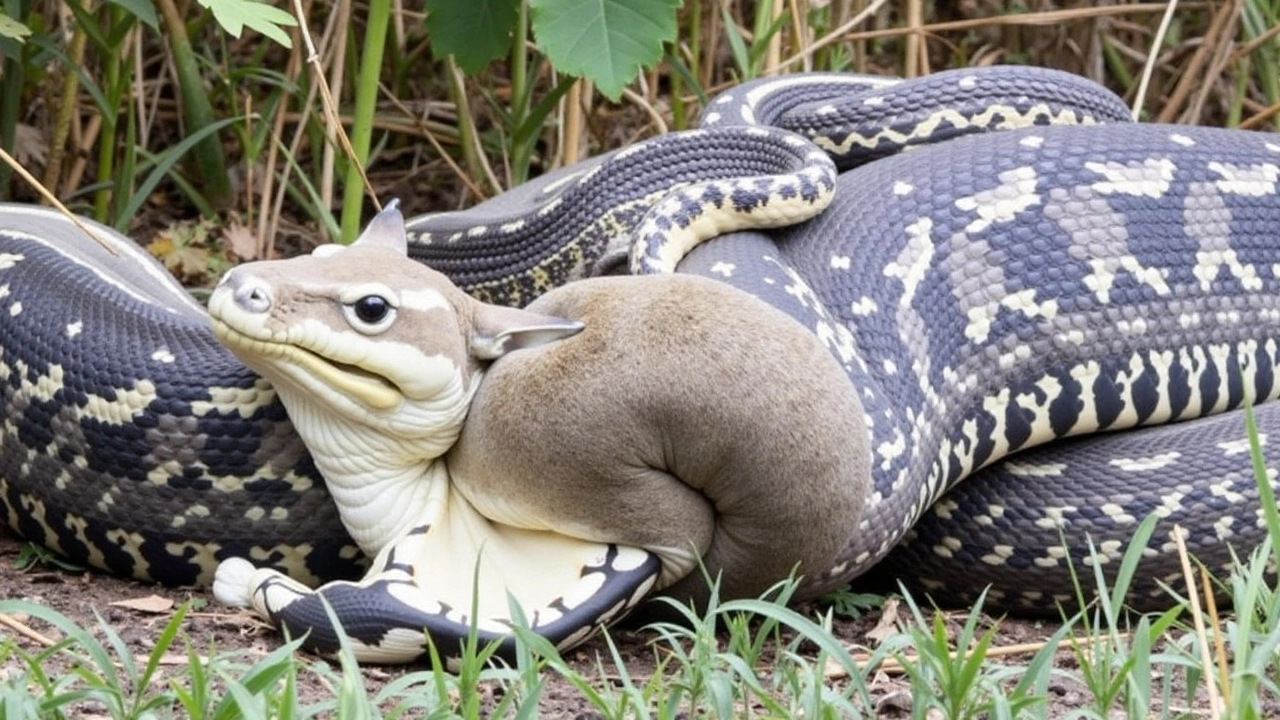The Jaw-Dropping Prey Consumption Abilities of Burmese Pythons in Florida

The Remarkable Eating Capabilities of Burmese Pythons
Burmese pythons, known for their formidable size and predatory prowess, have astounded the scientific community with their newfound ability to devour significantly larger prey than previously believed. Recent research published in the journal Reptiles & Amphibians has unveiled that these colossal snakes can expand their jaws up to a whopping 10.2 inches in diameter, shattering previous estimations. This newfound jaw capacity marks a substantial 1.5-inch increase from previous measurements, exciting researchers and raising important ecological questions. The unexpected revelation holds potential repercussions for the delicate fabric of Florida's ecosystem, where Burmese pythons now roam freely as invasive giants.
The Troubling Rise of an Invasive Predator
Although originally native to the lush landscapes of Southeast Asia, Burmese pythons have found an inadvertent home in the wetlands of Florida. Their astonishing ability to thrive in this new environment can be traced back to the pet trade. Exotic pet enthusiasts unknowingly opened the floodgates for these sprawling serpents through escapes and the occasional deliberate release by overwhelmed owners. As a result, these tenacious invaders have nestled comfortably among Florida's diverse ecosystems, manifesting as one of the most daunting ecological challenges the state has ever faced.
What makes Burmese pythons particularly threatening is their positioning as apex predators. In the wild, top predators are typically limited only by their capacity to physically engulf prey. However, the recent discovery of their expanded jaw opens a Pandora's box of ecological fallout. These snakes, venomless yet no less deadly, are now able to gnash down on animals that were once considered too large to fall victim to their biology. This development is troubling, as it extends their predatory reach to a much broader array of the fauna in their habitat.
The Role of Science in Uncovering Ecological Impact
This groundbreaking study was spearheaded by a team of researchers, including Bruce Jayne from the University of Cincinnati, and Ian Bartoszek of the Conservancy of Southwest Florida. Their collaborative endeavor aimed to dissect the biology behind the Burmese python’s astonishing gourmande prowess. By investigating the scaling relationship between the snake's sizable gape and its cranial structure, they unveiled the mechanics behind this newly discovered adaptation. Bruce Jayne aptly pointed out that the increased diameter translates to a 40 percent boost in the jaw's opening area, a critical finding that holds important ramifications for understanding the potential impact of these pythons within their invaded territories.
Implications for the Florida Ecosystem
The ecological implications are both sobering and profound. Burmese pythons have been documented consuming whole animals as sizable as 77-pound deer, prey approaching two-thirds of the snake's own body weight! This alarming aptitude now poses questions about the future of small to medium-sized mammals and birds populating the wetlands of the Everglades. As these apex predators flourish, there is a marked decline in populations of native animals like raccoons, foxes, and bobcats, all of which find themselves as unwitting fixtures on the menu of these voracious reptiles.
Estimating and Managing the Impact
Our understanding of invasive species is continually evolving, and as it stands, the potential for the Burmese pythons to upset the food web balance is a present reality rather than a distant possibility. The collaborative effort of wildlife researchers and conservationists in uprooting some of these predators has become imperative. Over 770 pythons have already been removed by the Conservancy of Southwest Florida, demonstrating an astonishing cumulative body mass exceeding 33,000 pounds. Every one of these pythons represents a critical unit capable of preying on animals the size of young deer.
The stark statistics bring forth a chilling visualization: if each captured snake were to satiate itself with just one normatively sized deer, ecological experts estimate a staggering 13,000 pounds of prey could be devoured across Florida's terrains. Such volume underscores the tangible threat these pythons pose to native wildlife, underscoring urgent calls for ecological management and intervention.

Towards Sustainable Solutions
Combating the Burmese python invasion requires innovation and actionable plans. Environmentalists are working fervently to pinpoint the most effective methods of curbing python populations. Community awareness is pivotal to these efforts, fostering a culture of responsibility among pet owners and involving residents in collaborative initiatives to report and capture pythons. Field campaigns to educate the public about the python’s impact are essential, informing on the risks and rewarding participation in python sighting reports.
A critical component of addressing the python challenge lies in ongoing research, tracking their proliferation patterns, understanding diet alterations, and tailoring response tactics. It’s a delicate balance, preserving Florida’s indigenous biodiversity while addressing the growing python presence.
Florida’s tale with the Burmese python offers a microcosm of the complex dynamics at play between invasive species and their adopted surroundings. It is a narrative woven with urgent calls to action, strategic collaboration, and unyielding spirit amongst conservationists. At the heart of it all lies a simple yet daunting challenge: safeguarding the ecological tapestry of the Everglades and ensuring a sustainable coexistence for generations to come.